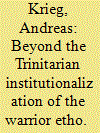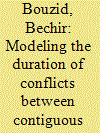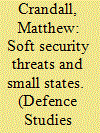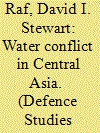|
|
|
Sort Order |
|
|
|
Items / Page
|
|
|
|
|
|
|
| Srl | Item |
| 1 |
ID:
128951


|
|
|
|
|
| Publication |
2014.
|
| Summary/Abstract |
Traditionally in liberal normative theory the warrior's ethos has been defined on basis of the warrior's raison d'être as the trinitarian protector of the social contractarian discretionary association of society and state. Since the post-modern warrior, whether serving in state uniform or as an employee of a commercial enterprise, is increasingly asked to provide security as a global rather than public good on the liberal state's behalf in non-trinitarian contingency operations, this paper provides a broader normative conceptualization of the post-modern warrior ethos. Trinitarian operations in this respect are defined as those operations that revolve around the state soldier's primary trinitarian function of providing security for society and state as a member of the Clausewitzian trinity of society, state and soldier. Instead of solely conceptualizing the warrior's ethos as a narrow trinitarian institutionalization process, this paper demonstrates that for the warrior who provides security increasingly in non-trinitarian operations, the post-modern warrior ethos becomes more and more an alternatively institutionalized characteristic of spirit beyond the social contractarian trinity. Shaping both the soldier's and the contractor's commitment in non-trinitarian contingency operations, the alternative non-trinitarian institutionalization of the warrior's ethos ensures that the post-modern warrior remains a virtuous and committed security service provider amid high operational risks even when serving the interests of common humanity rather than of his family, state and nation.
|
|
|
|
|
|
|
|
|
|
|
|
|
|
|
|
| 2 |
ID:
128949


|
|
|
|
|
| Publication |
2014.
|
| Summary/Abstract |
Several studies have devoted considerable energy toward explaining the occurrence of international conflicts between contiguous states. Despite the well-developed multidisciplinary approaches analyzing militarized disputes, which have predominately focused on studying the geographical dimension as an additional explanatory predictor of rivalry disputes, only very few research papers have considered modelling the duration of conflicts between neighbouring states. Using the event history analysis, we propose, rather than investigating the standard theoretical questions of why neighbouring states do fight each other, or alternatively, what factors commonly influence the dispute outcomes between those rival countries, instead to answer the question: Once it breaks out, what role does the geographic proximity of opponent states play when interacting with other factors, extending or conversely shortening the crisis period? One of the most relevant insights of the present work is that disputes that occur between adjacent countries tend to be shorter when joint democracies are involved, and when countries are dependent economically on each other. The presence of a territorial issue at stake or a long history of hostility over disputed areas tends to prolong the tension period as those disputes often include nationalism dimensions that increase the difficulty of reconciling the divergent views on the issues at stake. On the contrary, the present research does not provide strong support for some of the theoretical suggestions formulated by certain scholars regarding the positive correlation between the nature of opposing powers and the duration of conflict between neighbours.
|
|
|
|
|
|
|
|
|
|
|
|
|
|
|
|
| 3 |
ID:
128950


|
|
|
|
|
| Publication |
2014.
|
| Summary/Abstract |
This article will attempt to establish what is the relationship between domestic and international strategies taken by small states. To do this, Estonia will be used as a case study to examine how it has reacted to cyber-security, energy security, and national identity security. This work will take a qualitative critical approach that transcends common ontologies and epistemologies in International Relations. This will enable us to look at the relationship between levels of analysis, not just compartmentalize and compare them. A wide use of academic sources, open Estonian documents (both governmental and non-governmental), as well a semi-structured interview with an official of the Ministry of Defense will be used. This article concludes that small States will need to use all their resources, on both the domestic and international levels, to be successful in facing soft security.
|
|
|
|
|
|
|
|
|
|
|
|
|
|
|
|
| 4 |
ID:
128952


|
|
|
|
|
| Publication |
2014.
|
| Summary/Abstract |
There are conflicting views as to whether water scarcity will lead to cooperation or conflict. The central thesis of this paper is that conflict over water scarcity only becomes likely when it causes an existential threat to a population or state. The paper identifies a requirement for a new definition of the most severe levels of water scarcity in response to the concept of virtual water and proposes a new definition for absolute water scarcity based upon the presence of an existential threat to a population. Using the principles identified from a review of the water conflict debate and the new definition, the paper examines two Central Asian case studies to gauge the likelihood of conflict. In the case of the Aral Sea it concludes that regional geopolitics, assisted by international organisations should be able to find a compromise. In the case of Kazakhstan's Ili and Irtysh Rivers it takes the view that water scarcity, demographics and geopolitics are likely to cause China to export its insecurity to other nations. In so doing it may cause conflict that should be a concern to the UK and other nations.
|
|
|
|
|
|
|
|
|
|
|
|
|
|
|
|
|
|
|
|
|